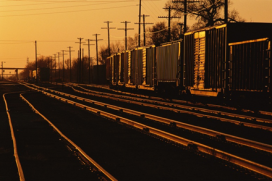Breaking Down Barriers on the Rails: Safety-Culture Initiative Improves Safety
Program evaluators have reported that the Federal Railroad Administration's (FRA) Clear Signal for Action (CSA)—a safety-culture initiative sponsored by FRA's Office of Research and Development—could significantly transform the railroad industry's safety culture when widely adopted. In a multi-year study, a team of program evaluators led by Dr. Joyce Ranney from Volpe, The National Transportation Systems Center, and the FRA concluded that the adoption of CSA principles and procedures provides significant improvements in overall safety. CSA continues to be one of the major safety culture initiatives within the Organizational Culture and Safety Performance Program that is led by Senior Evaluator Michael Coplen.
Spurred by a series of accidents in 2004, the FRA worked with Union Pacific Railroad (UP) at their San Antonio Service Unit (SASU) to implement a demonstration pilot to measure the extent to which peer-to-peer feedback, continuous improvement, and safety leadership development processes enhance overall safety. Behavioral Science Technology Inc. supported the implementation with UP.
"The most compelling part of this study and demonstration at SASU was not that CSA worked, but it was the extent and depth of adoption across staff and management that was exciting. The methodology in theory requires collaboration; however, the way everyone at SASU integrated CSA into their lives transformed the safety culture on their rails," said Volpe evaluator Dr. Michael Zuschlag.
Volpe's research showed that the Clear Signal for Action approach at the San Antonio Service Unit resulted in the following safety-related improvements:
- Worker practices improved with the program's introduction. Process metrics showed that workers' at-risk behaviors decreased approximately 80 percent.
- The rate of derailments and other incidents decreased by 81 percent at a rail yard with a strong CSA implementation. This rate of improvement was higher than at a location with a moderate implementation, which showed a 32-percent decrease. Rail yards with a weak implementation showed no significant change.
- The rate of engineer decertifications at SASU gradually declined by 79 percent after the introduction of CSA. During the same time period at service units without CSA, the rate of decertifications did not change significantly.
These results indicated that a widespread adoption of the CSA methodology could substantially reduce the rate of accidents, injuries, and fatalities. Volpe and the FRA are now developing a toolkit to share with the railroad industry that will streamline the CSA implementation process. Using the SASU demonstration as a framework, this toolkit will provide smaller companies like passenger rail carriers, short line railroads, and eventually high-speed rail carriers the opportunity to evolve their own safety.
Advancements like these illustrate how the FRA and Volpe work together to push forward ideas that will develop a safer, more efficient, and more effective infrastructure that can support the future state of the railroad industry.
More Information

- Read the SASU report in its entirety
- Read about another safety measure—Confidential Close Call Reporting System—that's been implemented on the railroads
